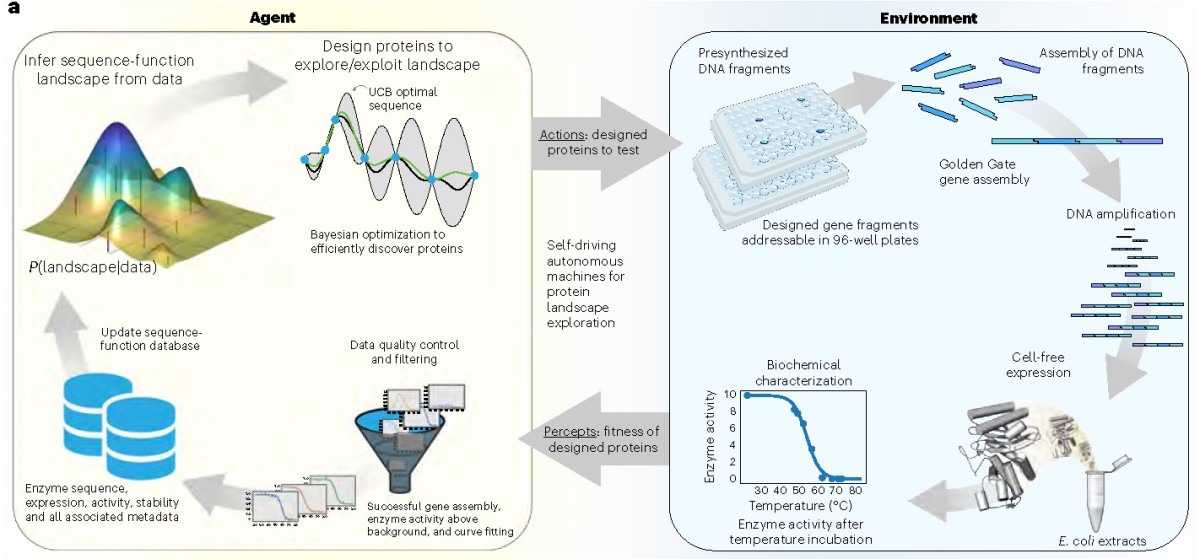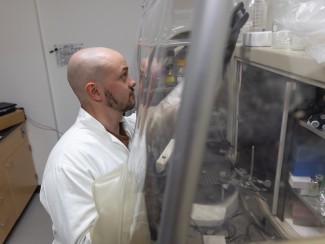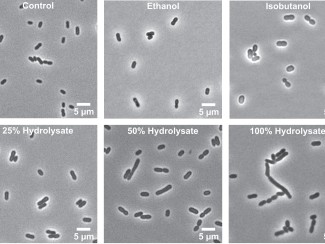Study: Machine learning coupled with robotic labs can amplify power of human researchers

Engineered proteins can treat diseases, clean up pollution, and produce better biofuels, but the work to create them is slow and tedious.
Now a team of scientists from the University of Wisconsin–Madison has designed a fully autonomous system that can do the work in a fraction of the time, amplifying the power of human researchers, according to a study published in the journal Nature Chemical Engineering.
Dubbed a self-driving laboratory, the system uses a computer algorithm (also called an agent) to identify the relationship between protein sequence and function and suggest changes likely to improve certain functions. The computer then sends the protein sequences to a robotic lab that tests them and provides feedback from experimental data to help the agent improve its “understanding” of the system and guide future rounds of experiments.
The entire process happens without any human intervention, which the authors say could accelerate the scientific discovery process and revolutionize biomolecular engineering and synthetic biology by allowing researchers to focus on more important problems, such as how to put these proteins to work.

Traditionally, protein engineering is monotonous and time consuming. Researchers start with a natural protein, then produce and test hundreds of mutated versions until they find one that has the properties they want.
A single round of testing can take a human researcher three to four days, said Jacob Rapp, a recent doctoral graduate who led the study with Philip Romero, a professor of biochemistry and Wisconsin Energy Institute affiliate.
A self-driving lab can do the same work in about nine hours, at least in theory. Even better, it can immediately start on the next round of tests, working around the clock.
“Humans don’t want to work nights and weekends,” Rapp said.
While machines to automate lab work aren’t new, this is the first instance of a fully-automated lab in a biological context where the machine is making decisions without human input, Rapp said.
Malfunctioning robots still faster than humans
To test the system, the team deployed four agents to engineer a type of enzyme that helps break down chemical bonds. Known as glycosyl hydrolases, these enzymes are frequently used in industrial applications, such as food processing, paper making, and bio-refining.
The goal was to make enzymes that tolerate higher temperatures. That’s important in industrial processes, such as biofuel refineries, where more heat speeds up chemical reactions.

The agents started with the same six natural genetic codes (sequences) and then designed three new sequences per round over 20 rounds. While each agent went about it in slightly different ways, all four quickly converged on enzymes that could withstand temperatures at least 12 degrees C warmer than natural enzymes.
While the computer excelled, the decade-old robot in the lab at the Great Lakes Bioenergy Research Center kept breaking down, so they eventually outsourced the robotics to a California-based lab and ran their algorithm through cloud computing.
Between restocking time, malfunctions, and a 2.5-month delay in getting new parts, the entire experiment took almost six months.
Even so, Rapp said, it would take up to a year for a human researcher to do the same work. With better planning, the team estimates that the system could perform 20 design-test-learn cycles in about two months.
Romero’s group is not the first to develop a “self-driving lab” for biological systems engineering, but they argue theirs is more autonomous, allowing more experiments without the need for human intervention.
Rapp said one of the biggest challenges was programming the computer to recognize and discard bad data, something that humans are naturally better at.
Romero’s group is now working to improve the algorithm and apply it to other protein engineering challenges.
Self-driving labs could be used to speed up research in other areas of biomolecular engineering and synthetic biology, such as modifying microbial metabolisms to be more efficient or to produce biofuels or other chemicals from plants or other biomass, Rapp said.
Rapp says the goal is not to replace scientists but to give them more time to work on bigger challenges.





